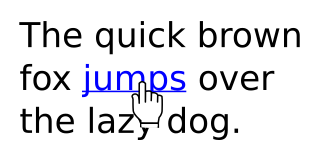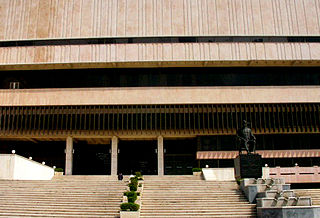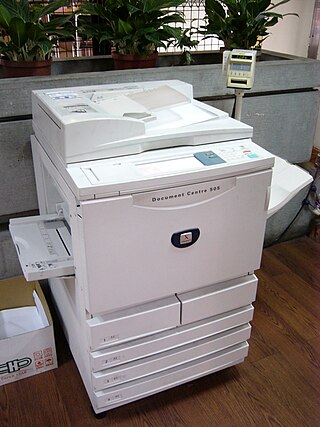
A book is a medium for recording information in the form of writing or images. Modern books are typically in codex format, composed of many pages that are bound together and protected by a cover; they were preceded by several earlier formats, including the scroll and the tablet. The book publishing process is the series of steps involved in their creation and dissemination.

In computing, a hyperlink, or simply a link, is a digital reference to data that the user can follow or be guided to by clicking or tapping. A hyperlink points to a whole document or to a specific element within a document. Hypertext is text with hyperlinks. The text that is linked from is known as anchor text. A software system that is used for viewing and creating hypertext is a hypertext system, and to create a hyperlink is to hyperlink. A user following hyperlinks is said to navigate or browse the hypertext.

Print on demand (POD) is a printing technology and business process in which book copies are not printed until the company receives an order, allowing prints in single or small quantities. While other industries established the build-to-order business model, POD could only develop after the beginning of digital printing because it was not economical to print single copies using traditional printing technologies such as letterpress and offset printing.

Stationery refers to writing materials, including cut paper, envelopes, writing implements, continuous form paper, and other office supplies. Stationery includes materials to be written on by hand or by equipment such as computer printers.
Copying is the duplication of information or an artifact based on an instance of that information or artifact, and not using the process that originally generated it. With analog forms of information, copying is only possible to a limited degree of accuracy, which depends on the quality of the equipment used and the skill of the operator. There is some inevitable generation loss, deterioration and accumulation of "noise" from original to copy when copies are made. This deterioration accumulates with each generation. With digital forms of information, copying is perfect. Copy and paste is frequently used by a computer user when they select and copy an area of text or content.

The Harvard Classics, originally marketed as Dr. Eliot's Five-Foot Shelf of Books, is a 50-volume series of classic works of world literature, important speeches, and historical documents compiled and edited by Harvard University President Charles W. Eliot. Eliot believed that a careful reading of the series and following the eleven reading plans included in Volume 50 would offer a reader, in the comfort of the home, the benefits of a liberal education, entertainment and counsel of history's greatest creative minds. The initial success of The Harvard Classics was due, in part, to the branding offered by Eliot and Harvard University. Buyers of these sets were apparently attracted to Eliot's claims. The General Index contains upwards of 76,000 subject references.

A scroll, also known as a roll, is a roll of papyrus, parchment, or paper containing writing.
The Internet History Sourcebooks Project is located at the Fordham University History Department and Center for Medieval Studies. It is a web site with modern, medieval and ancient primary source documents, maps, secondary sources, bibliographies, images and music. Paul Halsall is the editor, with Jerome S. Arkenberg as the contributing editor. It was first created in 1996, and is used extensively by teachers as an alternative to textbooks.
A sourcebook is a collection of texts on a particular subject intended for use as an introduction to the subject. The selected texts are typically edited, laid out, and typeset in a uniform format before binding, and the result is often a hardcover book similar to a textbook. In contrast, course readers are prepared by simply photocopying or scanning the selected materials and then adding covers, front matter, tables, and pagination, they are usually bound as softcover books, and they are usually prepared for a specific course.
Redaction or sanitization is the process of removing sensitive information from a document so that it may be distributed to a broader audience. It is intended to allow the selective disclosure of information. Typically, the result is a document that is suitable for publication or for dissemination to others rather than the intended audience of the original document.

A lead sheet or fake sheet is a form of musical notation that specifies the essential elements of a popular song: the melody, lyrics and harmony. The melody is written in modern Western music notation, the lyric is written as text below the staff and the harmony is specified with chord symbols above the staff.

A film still is a photograph, taken on or off the set of a movie or television program during production. These photographs are also taken in formal studio settings and venues of opportunity such as film stars' homes, film debut events, and commercial settings. The photos were taken by studio photographers for promotional purposes. Such stills consisted of posed portraits, used for public display or free fan handouts, which are sometimes autographed. They can also consist of posed or candid images taken on the set during production, and may include stars, crew members or directors at work.

Al-Assad National Library is the national library of Syria, located in the capital Damascus overlooking the Umayyad Square. It's named after Hafez al-Assad.

A photocopier is a machine that makes copies of documents and other visual images onto paper or plastic film quickly and cheaply. Most modern photocopiers use a technology called xerography, a dry process that uses electrostatic charges on a light-sensitive photoreceptor to first attract and then transfer toner particles onto paper in the form of an image. The toner is then fused onto the paper using heat, pressure, or a combination of both. Copiers can also use other technologies, such as inkjet, but xerography is standard for office copying.

Bookbinding is the process of building a book, usually in codex format, from an ordered stack of paper sheets with one's hands and tools, or in modern publishing, by a series of automated processes. Firstly, one binds the sheets of papers along an edge with a thick needle and strong thread. One can also use loose-leaf rings, binding posts, twin-loop spine coils, plastic spiral coils, and plastic spine combs, but they last for a shorter time. Next, one encloses the bound stack of paper in a cover. Finally, one places an attractive cover onto the boards, and features the publisher's information and artistic decorations.
Copyright Clearance Center (CCC) is a U.S. company based in Danvers, Massachusetts,, that provides collective copyright licensing services for corporate and academic users of copyrighted materials. CCC procures agreements with rightsholders, primarily academic publishers, and then acts as their agent in arranging collective licensing for institutions and one-time licensing for document delivery services, coursepacks, and other access and uses of texts.

The following outline is provided as an overview of and topical guide to books.

Alberta (Education) v Canadian Copyright Licensing Agency , 2012 SCC 37, is a Supreme Court of Canada case that considered whether the photocopying of textbook excerpts by teachers, on their own initiative, to distribute to students as part of course materials is fair dealing pursuant to the provisions of the Copyright Act. The Supreme Court, in a 5/4 split, concluded that the Copyright Board made several errors in its analysis of the "fairness factors". Thus, it allowed the appeal and remitted the matter back to the Copyright Board for reconsideration.

The Chancellor, Masters and Scholars of the University of Oxford and Others v. Rameshwari Photocopy Services and Others, colloquially known as the DU Photocopy Case, was an Indian copyright law court case in the Delhi High Court filed by academic publishers Oxford University Press, Cambridge University Press and Taylor & Francis, against Rameshwari Photocopy Services and the University of Delhi, the former being a shop licensed to operate within the precincts of the Delhi School of Economics, University of Delhi. The plaintiffs alleged copyright infringement and sought a permanent injunction, and the defendants successfully argued that their actions fell within the bounds of fair dealing.
Indian Reprographic Rights Organisation (IRRO) is a copyright society established under Section 33 of the Copyright Act, 1957. Its main objective is to ensure that the copyrights of authors are protected and that copyright owners are respected and rewarded when their original works are used and reproduced. The guidelines of regulating copyrights by IRRO are curated in a fair way that rewards the authors, creators, and publishers and allows easy reproduction of their works and publications. The organization deploys the highest ethical standards when it comes to dealing with the rights of authors, collecting and distributing remunerations, and the bonafide funds they hold.













